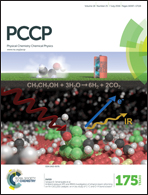Molecular and mesoscale mechanism for hierarchical self-assembly of dipeptide and porphyrin light-harvesting system†
Abstract
A multi-scale theoretical investigation of dipeptide–porphyrin co-assembly systems has been carried out to establish such understanding, where two different types of the dipeptides, dilysine (KK3+) and diphenylalanine (FF+) are compared on tuning the porphyrin organization. Density functional theory results reveal that the electrostatic attraction between different functional groups has significantly strengthened the hydrogen bonds between them, which are considered as the driving force of the self-assembly at the molecular level. All-atom molecular dynamics (MD) simulation further indicates that the formation of the core–shell nanorods is driven and stabilized by the hydrophobic interaction between dipeptides and negatively charged porphyrin (H2TPPS2−), where the packed porphyrins stay inside as the core of the nanorods and the hydrophilic groups (amino- and carboxyl-groups) as the shell. With stronger hydrophobicity, FF+ is more likely to insert into the porphyrin aggregates and build crosslinks than KK3+. Moreover, dissipative particle dynamics (DPD) simulation suggests equilibrium morphologies with different dipeptides, where KK3+–H2TPPS2− assembled in fiber bundles, whereas FF+–H2TPPS2− assembled as microspheres, corresponding to the different packing behavior in MD simulations. The consistency of these results at different scales is discussed. The method used in this work could be extended for studying similar issues in hierarchical self-assembly of building blocks such biomaterials.


 Please wait while we load your content...
Please wait while we load your content...